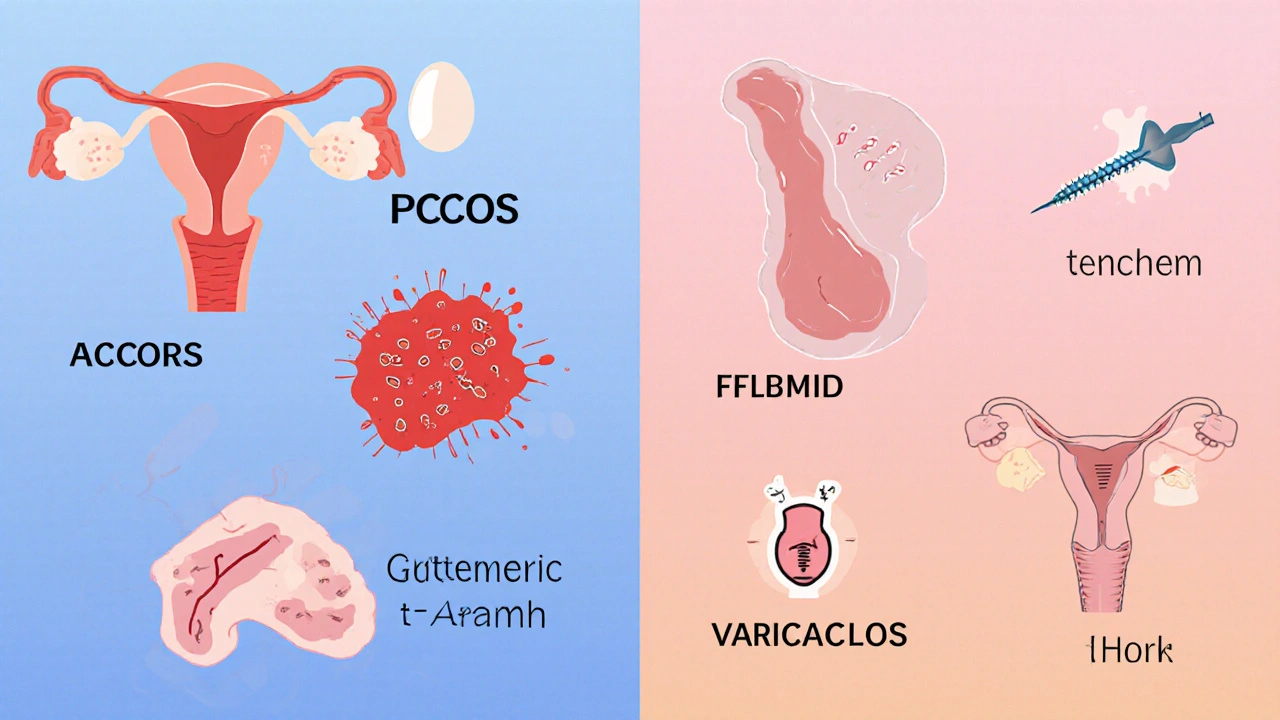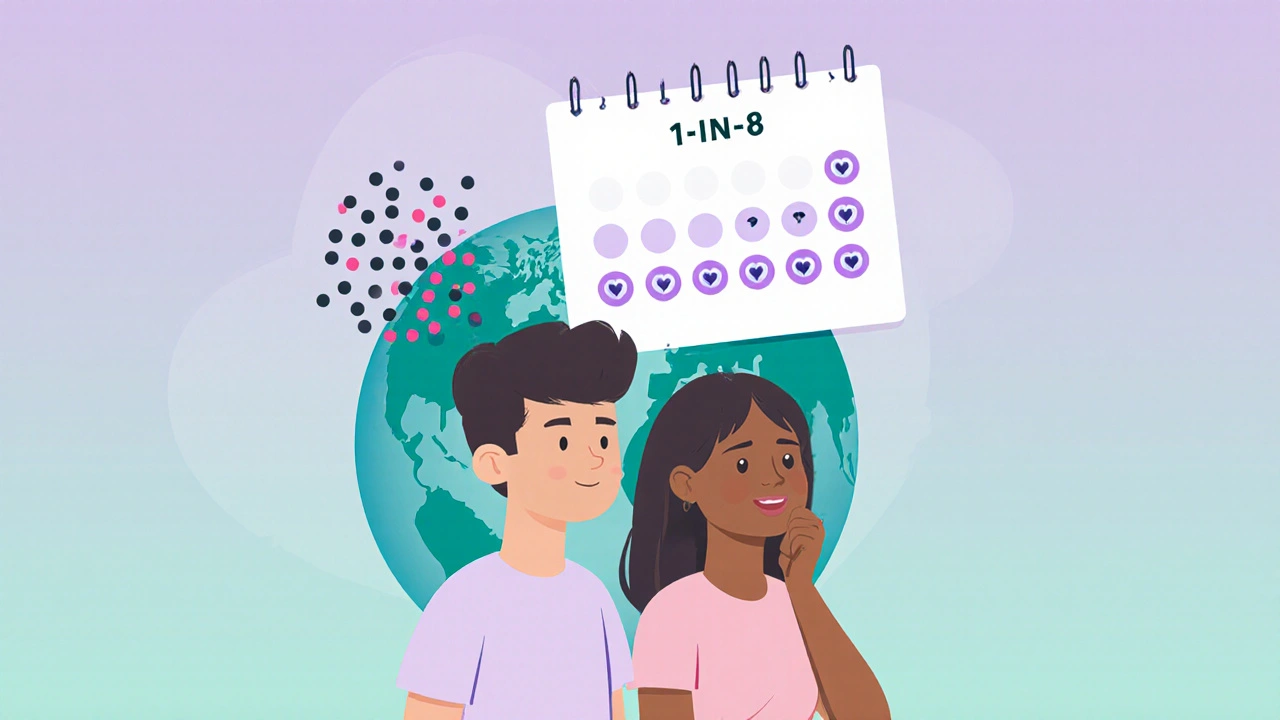Key Takeaways
- Infertility affects about 1 in 8 couples worldwide.
- Both male and female factors contribute, often together.
- Age, lifestyle, and environmental exposures significantly impact fertility.
- Accurate diagnosis requires a step‑by‑step workup for both partners.
- Modern assisted‑reproductive technologies give many couples a realistic chance of pregnancy.
When couples face Infertility is a medical condition where a couple cannot achieve pregnancy after a year of regular, unprotected intercourse, understanding the underlying infertility causes is the first step toward effective treatment.
What Exactly Is Infertility?
Infertility is not just a women’s issue; it’s a health problem that involves both partners. According to the World Health Organization, roughly 15% of reproductive‑age couples experience difficulty conceiving. The condition is usually defined as the inability to achieve a clinical pregnancy after 12 months of consistent, unprotected sex.
Beyond the emotional strain, infertility can signal deeper health concerns-hormonal imbalance, chronic disease, or even early signs of systemic conditions. Recognizing it early helps prevent complications later in life.
Broad Categories of Causes
Infertility can be grouped into three overarching categories:
- Female factors
- Male factors
- Combined or external influences (lifestyle, environment, genetics)
Often, more than one of these categories overlaps, making a comprehensive evaluation essential.
Female‑Related Causes
Female infertility accounts for roughly 40‑45% of cases. Below are the most common contributors:
Ovulation Disorders
Ovulation disorders are conditions where the ovaries fail to release an egg regularly. Without a viable egg, fertilisation cannot occur.
Polycystic Ovary Syndrome (PCOS)
Polycystic ovary syndrome (PCOS) is a hormonal disorder marked by irregular periods, excess androgen, and polycystic ovaries. It’s the single biggest cause of anovulatory infertility, affecting up to 10% of women of reproductive age.
Endometriosis
Endometriosis occurs when tissue similar to the uterine lining grows outside the uterus, causing inflammation and scarring. This can obstruct the fallopian tubes or impair egg quality.
Age‑Related Decline
Female fertility peaks in the early 20s and gradually declines after 30. By age 40, the chances of natural conception drop to under 5% per cycle, and miscarriage rates rise sharply.
Uterine and Cervical Issues
Fibroids, polyps, congenital uterine anomalies, or cervical stenosis can prevent implantation or block sperm entry.
Male‑Related Causes
Male factors are responsible for about 30‑35% of infertility cases. The most frequent issues include:
Sperm Production Problems
Male factor infertility often stems from low sperm count, poor motility, or abnormal morphology. These parameters are assessed via a semen analysis.
Hormonal Imbalances
Low testosterone, elevated prolactin, or thyroid disorders can disrupt spermatogenesis.
Structural Blockages
Varicoceles, ejaculatory duct obstruction, or prior surgeries (e.g., vasectomy reversal) can physically block sperm delivery.

Lifestyle and Environmental Influences
Even when medical causes are absent, everyday habits heavily influence fertility.
Body Weight
Both obesity (BMI > 30) and extreme underweight (BMI < 18) alter hormone levels, reducing ovulation in women and sperm quality in men.
Smoking and Alcohol
Cigarette smoke introduces oxidative stress that damages DNA in sperm and eggs. Heavy alcohol consumption (> 14 drinks/week) can lower testosterone and disrupt menstrual cycles.
Environmental Toxins
Environmental toxins such as phthalates, bisphenol A (BPA), and pesticides have been linked to reduced fertility in both sexes. These chemicals can act as endocrine disruptors.
Stress
Chronic stress elevates cortisol, which can suppress the hypothalamic‑pituitary‑gonadal axis, leading to irregular cycles or lowered sperm production.
Genetic and Health‑Related Factors
Underlying health conditions can quietly impair reproductive function.
Thyroid Disorders
Hyper‑ or hypothyroidism disrupts menstrual regularity and can affect sperm parameters.
Diabetes
Poorly controlled diabetes damages blood vessels and nerves, contributing to erectile dysfunction and ovulatory issues.
Genetic Abnormalities
Genetic abnormalities such as Klinefelter syndrome (XXY) in men or Turner syndrome (XO) in women can cause infertility. Chromosomal testing is recommended for unexplained cases.
Diagnostic Workup: How Doctors Pinpoint the Issue
- Medical History Review: Detailed discussion of menstrual patterns, sexual history, past surgeries, and lifestyle.
- Physical Examination: Pelvic exam for women; testicular and prostate exam for men.
- Hormone Testing: Serum FSH, LH, estradiol, prolactin, TSH, and testosterone levels.
- Semen Analysis: Volume, concentration, motility, and morphology assessed after 2-7 days of abstinence.
- Imaging Studies: Transvaginal ultrasound for ovarian reserve; hysterosalpingography (HSG) to check tubal patency; scrotal ultrasound for varicoceles.
- Advanced Tests: Anti‑Müllerian hormone (AMH) for ovarian reserve, genetic panels, and laparoscopic evaluation for endometriosis.
Each test helps narrow down the specific cause and guide treatment choices.
Treatment Options Tailored to the Cause
Once the root cause is identified, a range of interventions can be considered:
Medication
- Clomiphene citrate or letrozole to induce ovulation.
- Metformin for PCOS‑related insulin resistance.
- Thyroid hormone replacement or antithyroid drugs as needed.
Surgical Interventions
- Laparoscopic removal of endometriosis implants.
- Myomectomy for large fibroids.
- Varicocelectomy to improve sperm quality.
Assisted Reproductive Technology (ART)
Assisted reproductive technology (ART) encompasses a spectrum of laboratory‑based procedures that help achieve pregnancy. The most common forms are:
- Intrauterine insemination (IUI): Sperm is processed and placed directly into the uterus around ovulation.
- In vitro fertilization (IVF): Eggs are retrieved, fertilised with sperm in the lab, and the resulting embryo(s) are transferred back to the uterus.
- Intracytoplasmic sperm injection (ICSI): A single sperm is injected into an egg, useful for severe male factor infertility.
Success rates vary with age, underlying cause, and clinic expertise. For women under 35, IVF live‑birth rates hover around 45%, while they drop below 15% after 40.
Quick Comparison: Female vs. Male Causes
| Aspect | Female Factors | Male Factors |
|---|---|---|
| Common Conditions | Ovulation disorders, PCOS, Endometriosis, Age‑related decline | Low sperm count, Motility issues, Varicocele, Hormonal imbalance |
| Diagnostic Tests | AMH, HSG, Pelvic ultrasound, Hormone panel | Semen analysis, Hormone panel, Scrotal ultrasound |
| Treatment Focus | Ovulation induction, Surgery, IVF | Lifestyle changes, Hormone therapy, ICSI |
| Impact of Age | Sharp decline after 35 | Gradual decline; still viable into 50s |
| Success with ART | IVF success linked to ovarian reserve | ICSI boosts fertilisation when sperm quality is low |
Checklist: Steps to Take When Facing Infertility
- Schedule a joint appointment with a reproductive endocrinologist.
- Maintain a healthy diet, achieve a balanced BMI, and avoid smoking.
- Limit alcohol to ≤ 7 drinks/week and reduce caffeine to < 300 mg/day.
- Track menstrual cycles using a fertility app or basal body temperature.
- Ask for a comprehensive semen analysis even if you feel fine.
- Consider genetic counseling if there’s a family history of early menopause or male infertility.
- Explore insurance coverage for ART; many plans now partially reimburse IVF cycles.
Frequently Asked Questions
How long should a couple try before seeking medical help?
If you’re under 35, wait 12 months of regular, unprotected intercourse. Over 35, start the evaluation after 6 months.
Can lifestyle changes actually improve fertility?
Yes. Losing excess weight, quitting smoking, and reducing alcohol can boost both sperm quality and ovulation rates within 3-6 months.
Is IVF the right choice for everyone?
IVF is most effective when other options have failed or when there are severe male or female factors. Age, ovarian reserve, and financial considerations also play a role.
What is the success rate of ICSI?
ICSI results in fertilisation in about 70‑80% of cycles for men with low sperm count or motility, leading to similar pregnancy rates as conventional IVF when good embryos are available.
Are there any risks associated with fertility medications?
Common side effects include hot flashes, mood swings, and ovarian hyperstimulation syndrome (OHSS). OHSS is rare but can be serious; monitoring by a specialist mitigates risks.
Wrapping Up
Infertility isn’t a single‑cause problem; it’s a puzzle made of hormonal, anatomical, lifestyle, and genetic pieces. By breaking down each factor, getting the right tests, and choosing evidence‑based treatments, most couples can move from uncertainty to a realistic chance of pregnancy. Remember: early evaluation, a healthy lifestyle, and open communication with your care team are the three pillars that turn the tide.



 Medications
Medications





Rachael Turner
October 22, 2025 AT 17:42Seeing this comprehensive overview makes me think about how often we treat infertility as a single problem when it’s really a collection of many threads woven together. It invites us to look beyond the obvious and consider lifestyle, age, and hidden health issues. The guide’s step‑by‑step tone feels like a gentle hand guiding a lost traveler. I appreciate the balance of medical detail and empathy.
Suryadevan Vasu
October 31, 2025 AT 10:09The emphasis on a joint evaluation aligns with best practice guidelines. Early hormonal assessment can reveal subtle imbalances. A systematic workup saves time and uncertainty.
Iris Joy
November 9, 2025 AT 03:35Infertility is a journey that often begins with confusion and fear, but knowledge can become a steady compass. Understanding that both partners contribute to the challenge removes the misplaced blame that many couples endure. Hormonal cycles are delicate rhythms, and any disruption can echo through the entire reproductive system. For women, conditions like polycystic ovary syndrome not only affect ovulation but also impact metabolism and emotional wellbeing. Endometriosis, with its hidden lesions, can silently scar the pelvic environment, making implantation a steep uphill battle. Age remains a relentless factor; the ovarian reserve declines steadily after the early thirties, and each passing year reduces the pool of viable eggs. Men, too, face their own hurdles, as sperm production can be hampered by lifestyle choices, environmental toxins, and genetic anomalies. A high BMI, whether from obesity or extreme leanness, skews hormone levels on both sides of the equation. Smoking introduces oxidative stress that damages DNA in both eggs and sperm, a risk often underestimated. Alcohol, especially in excess, interferes with testosterone production and disrupts menstrual regularity. Stress, the invisible antagonist, elevates cortisol and can suppress the hypothalamic‑pituitary‑gonadal axis, leading to irregular cycles or diminished sperm count. Thyroid disorders, both hyper and hypo, ripple through the reproductive cascade, altering follicular development and semen parameters. Diabetes, when poorly controlled, damages blood vessels and nerves, jeopardizing erectile function and ovulatory health. Genetic conditions such as Klinefelter or Turner syndrome remind us that chromosomal makeup can set boundaries on fertility potential. The diagnostic workup outlined in the guide-history, physical exam, hormone panels, imaging, and semen analysis-serves as a map to pinpoint these diverse obstacles. Ultimately, each identified cause opens a targeted treatment pathway, whether through medication, surgery, lifestyle modification, or assisted reproductive technologies, turning uncertainty into a realistic chance of pregnancy.
Joe Waldron
November 17, 2025 AT 21:02The systematic approach you described, with its sequential tests, indeed creates a clear diagnostic pathway; however, patient anxiety often spikes during the hormonal panels, which can affect results, so clinicians should provide reassurance. Imaging studies, such as transvaginal ultrasound, offer valuable insights; yet, they are operator‑dependent, and consistency is key. Semen analysis remains the cornerstone for male assessment, but variability between labs necessitates standardization, otherwise interpretation becomes murky. Lifestyle counseling, while seemingly simple, must be integrated early, because weight, smoking, and alcohol profoundly influence both sperm and oocyte quality. Finally, the interplay of multiple factors, as you noted, underscores the need for a multidisciplinary team, including endocrinologists, urologists, and mental health professionals.
Joanne Ponnappa
November 26, 2025 AT 14:29Great summary of the main causes, easy to read. It helps people see how many factors matter. 👍
Michael Vandiver
December 5, 2025 AT 07:55Love it 😄
Harini Prakash
December 14, 2025 AT 01:22Thanks for laying everything out so clearly, it really demystifies the process. I think many couples get stuck on the idea that infertility is only a woman's issue, but this guide shows the balance. The sections on lifestyle tweaks are especially useful – even small changes can shift the odds. If you’re feeling overwhelmed, remember that each step you take is progress 😊.
Diane Thurman
December 22, 2025 AT 18:49Honestly the guide is good but it could use more on the real life cost of IVF it’s not just about success rates, many cant afford it. Also the part about stress is a bit vague, stress is not just a feeling it changes hormones. Maybe add a paragraph on mental health support.